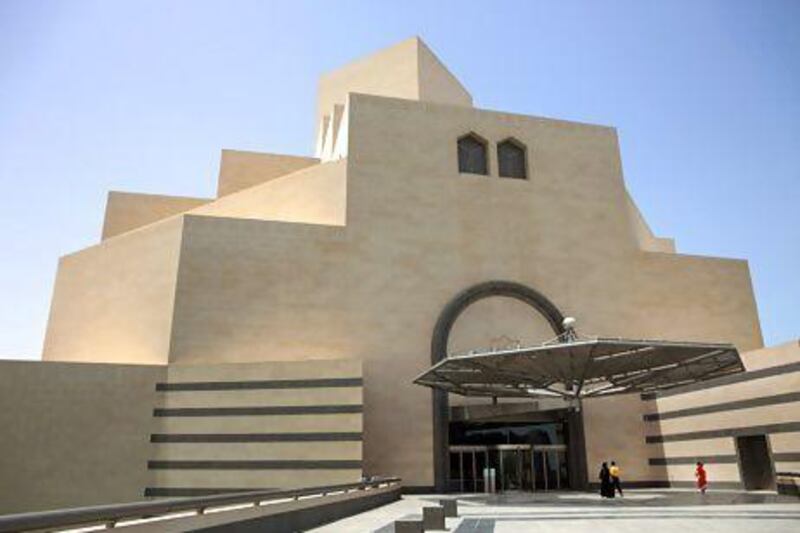You are one of the world's leading chefs and you want to create that special dish using luxury ingredients for your new restaurant in the Middle East.
What can it be? Alain Ducasse has the answer: camel.
Braised for six days and served with foie gras, soufflé potatoes and truffle sauce, it is the standout dish at Idam, housed within the Museum of Islamic Art in the Qatari capital of Doha. No alcohol is served and there's no wine in the cooking.
"The camels can't be too young or too old," Mr Ducasse, 56, says sitting in the dining room.
He says the dish took months to perfect with his executive chef, Romain Meder. At 320 riyals (Dh322.8) it is the top-priced main course.
You might order it after a starter of marinated bonito fish from the Arabian Gulf, with lemon and gold caviar.
That costs 225 riyals. Most mezze dishes cost between 45 and 90 riyals. Idam, which can seat 60 guests, is Mr Ducasse's first restaurant in the Middle East and took 18 months to develop.
"The camel dish is a local adaptation of a Rossini," he says.
"We work locally with the meat, which is precious here. It's very, very high end.
"We hang it in the fridge for three to four weeks and we slow cook it, braise it, for six days to reach the level of tenderness: five days at one temperature and the last day a little higher to fix the colour.
"When we go somewhere, we don't impose: we propose. It's a dish that the locals really like. It's like braised spare ribs but there's no red wine. There's no wine in anything.
"The jus that results from the braising is a natural jus from the meat itself and the vegetables that accompany it."
It's hours before the official opening VIP banquet and Mr Ducasse is looking relaxed. He's dressed in his chef's whites and talks happily in French through an interpreter, except when she is called away and he switches to English.
The restaurant is designed by Philippe Starck, who was present for the opening and was in philosophical mood.
"My job is to manage the energy," he said of the space.
"I've used no colour, except for some glassware. It's the people who will bring the colour. I love life, and all my life I've believed in the idea of democratic design. Everyone can leave here with a memory," he says.
"What could be more democratic than that?"
It's difficult to imagine anyone leaving the museum without many memories. The architecture, by IMPei, is spectacular in its beauty and harmony.
The museum stands on an artificial island reached by bridges and features a five-storey atrium. The restaurant is on an upper floor, with a view into the atrium on one side and out to the Arabian Sea on the other.
Mr Ducasse says it was a challenge to create a restaurant where wine is not served. He and his team developed a range of drinks with different levels of sweetness and acidity to complement the dishes. With the camel, you might try So Good, a mix of white grape juice, tonic, iced tea and rose syrup.
Mr Meder, his executive chef, travelled across North Africa and the Middle East to widen his knowledge of local flavours.
"It's contemporary French cuisine with a mix of taste and spices from the Middle East," Mr Ducasse says.
"In spirit, we're closer to the cuisine that we could imagine to do in Monaco than the cuisine we do in Paris at the Plaza Athenee."
He is very much in demand, with more than 20 restaurants worldwide. He arrived from Chicago for the January 26 opening of Idam and he is developing a restaurant called Rivea at the Hotel Byblos in Saint Tropez.
He has not given up on the idea of a fine-dining restaurant in New York, where he closed Adour at the St Regis in November.
"Adour is over: it's a liberation," he says.
"It was very difficult with the restaurant and the hotel being unionised. It was becoming impossible to operate a restaurant, so it's good news," he says.
"We're looking for somewhere now but not in a hotel."
Guests at the opening banquet were served about a dozen dishes, including chickpeas and lentils harira; preserved duck foie gras, date-sesame citrus; roasted Brittany lobster, zaalouk-style courgette, stuffed flower; and camel shank.
Will camel catch on? Mr Ducasse says he could imagine serving it in London, where many people travel from the Middle East.
Maybe even locals would get a taste for it - Mr Ducasse compares it to spare rib, and the flavour is vaguely beefy but with more than a hint of the farmyard.
For Londoners though, a big, bold glass of red wine might help.
* Bloomberg News





